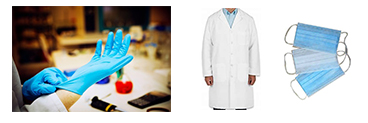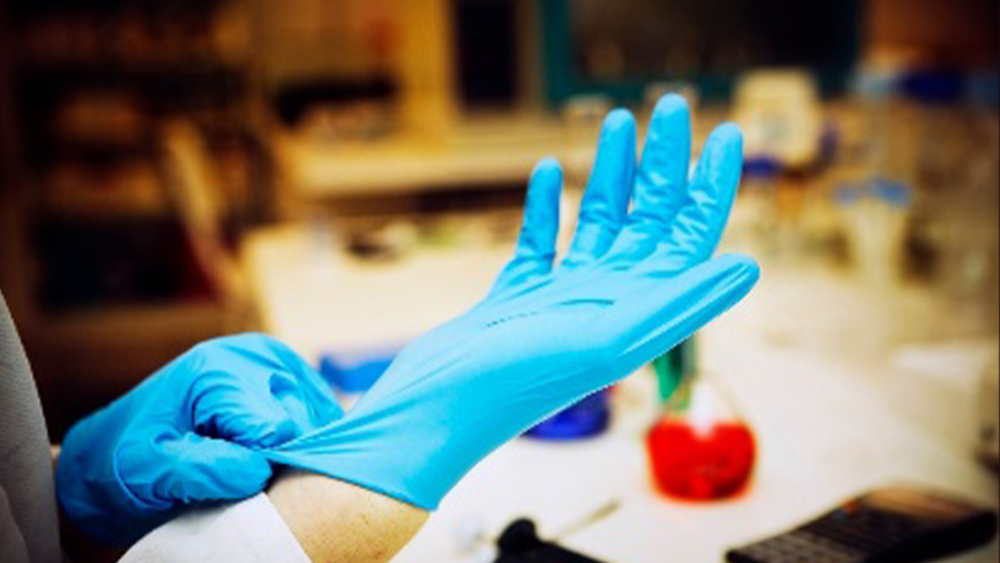Part 1 – Enhancing Personal Body Protection
The definition of a ‘novel’ virus is a virus that has not been previously seen or documented in its present form. While a new virus may be in the same family of other known viruses, it predictably will have a variation of symptoms, methods of transmission from person to person, and the pathogenic nature of how it manifests in the body. COVID-19 is in the family of highly contagious respiratory viruses called Coronavirus, such as ‘severe acute respiratory syndrome’ (SARS), ‘Middle Eastern respiratory syndrome’ (MERS), and others. Understanding like viruses in the family helps us develop initial methods of defense. However, the unknown nature of any new highly infectious disease presents not only the ultimate goal of developing a cure, but more immediately how do we protect ourselves daily in the midst of its presence in our community, our families, and on our jobs? The images above show examples of standard laboratory protection such as gloves, long sleeve lab coats, and face masks.

Personal Protective Equipment (PPE) is a phrase not uncommon to laboratory operations, but one that is specific in nature to the respective lab environment and the safety liabilities within. The key words are ‘personal protective’ and cover a wide range of clothing and gear that serve as an effective barrier for you from any biological (bacteria, virus, etc.) or physical/chemical (heat, chemicals, etc.) hazards. In Histopathology, standard PPE practices of Histopathology are generally always in use, but with the ‘unknown’ aspect of COVID-19, enhancing our standard methods is not only warranted but mandatory. Protecting ourselves on our jobs through enhanced PPE begins with:
- Taking the knowledge that we currently have about the virus or like viruses and how they are contained or deactivated
- Making an assessment of all personal areas of possible direct or in-direct exposure
- Applying standard ‘and’ enhanced methods of protective clothing and gear as the new norm
Part 1 of this article will deal specifically with enhancing your personal bodily protection and minimizing your risk of exposure. Given the efficacy of which COVID-19 is transmitted from person to person, and the asymptomatic nature for some of being infected with no signs, one person could easily contract the virus and spread it to others without indicators. Even a person who does exhibit symptoms can be contagious for 4-5 days before signs. In the current climate of unknown it is advisable to operate under the mindset that the virus is alive and active at your workplace and possibly with those in your immediate vicinity.

The Center for Disease Control (CDC) guidelines on hand hygiene for healthcare workers emphasizes one of the most basic areas to be addressed, the hands. With few exceptions 100% of our physical interaction with our environment is through the hands. CDC guidelines states that the use of an alcohol-based rub/sanitizer, OR the use of soap and water washing should be practiced with the various tasks performed during the work shift. The CDC states a preference to the alcohol-based sanitizers over soap and water because there is evidence of better compliance from workers because sanitizers are less irritating to the hands and more easily accessible when there is no sink available. The CDC standard determines hands should be washed vigorously for at least 15-20 seconds. This pre-existing CDC standard can be enhanced by performing it whenever you go from one room/section in the Histology lab to another, such as going from the embedding or processing room to the core lab; or even one section in the lab to another, such as microtomy to special stains. The main goal is to minimize the risk of carrying a contaminant from one area to another.
With respect to gloves, in many histology laboratories wearing gloves during microtomy is more of an optional convenience rather than a mandated safety standard. However, studies of like viruses have been noted to show they remain active on surfaces such as workstation countertops, microtomes, microscopes, etc., for multiple days. During this season of heightened precautions, wearing gloves during microtomy as well as in general in the lab, increases your defense against contact transmission. If resources (gloves) are limited in the lab and multiple changes are not practical, a lesser but still effective method of disinfection can be achieved through the use of 4×4 gauze soaked in 70% alcohol and thoroughly wiping down all surface areas of the glove. This application will be discussed further in Part 2 of the article (Environmental Safety). This can help to conserve gloves to a point, and still enhance your safety.
Lab coats should be a mandate in the laboratory, even if you are presently wearing hospital scrubs. The lab coat should be long sleeved and kept constantly buttoned or tied to avoid easy contamination of clothing. Ideally lab coats should have elastic cuffs and fitted outside the gloves. Strict ‘enforcement’ of lab coat policy where lab coats are never worn outside of the work environment must be maintained. A tremendous enhancement to the lab coat effectiveness, particularly when working with frozen sectioning, in the gross room, or under a fume hood, is applying the added protection of Tyvek sleeves. The image above illustrates that when used in conjunction with gloves, this can be a very effective enhanced method of protection.

Protective masks are not commonly worn in most routine duties in the Histology lab, however in lieu of current events and the risk assessment, many laboratories are now using some form of facial protection as a general routine. Two types of masks that have been used most frequently in lab infection control are the N95 (which are more appropriately designed for front-line healthcare workers involved in direct contact patient care), and the standard surgical mask. The N95 mask provides a superior 2-way protection from external transmission (patient to caregiver) and internal exposure (caregiver to patient) blocking airborne particles both ways. It requires proper tight fitting on the workers face and is more difficult to wear for long periods because it reduces air flow and oftentimes causes some difficulty in breathing. The standard surgical mask is easier to wear and exchange but serves as more of a physical barrier for one-way transmission from caregiver to patient. It blocks airborne particles emitted during breathing, coughing, or speaking from reaching the patient. Because of its loose fitting and thinner filtration material, it is not as effective as the N95 mask in protecting healthcare workers from external transmission. However, the surgical mask is more appropriately designed for standard laboratory use. Remember, a non-symptomatic coworker who has the virus could easily infect others without knowledge or warning signs. At the time of the writing of this article, the CDC states that 25% of people testing positive for COVID-19 virus were asymptomatic. Histology laboratories would be well advised to consider the use of this device regularly, even during microtomy, to help reduce the possibility of transmission.

Safety glasses and face shields are other standard PPE gear that should be considered with more frequency, especially in areas of the lab where particulate spray or fluids can be splashed or put into aerosol form. Grossing stations (bone saws), staining areas, tissue processor maintenance (reagent change/rotation), and even using a standard sink for rinsing specimens or tests; all of these require protection from the risk of eye/mouth/face exposure.
There are many challenges in adopting a comprehensive personal protection equipment package. We have shown just a few options. There is no absolute solution because the most appropriate clothing/gear will vary from laboratory to laboratory, and even within the laboratory from one section to another. Shortage of resources may unfortunately determine the extent of which you can have access to certain PPE methods, but personal safety is paramount to the health care professional. As previously stated, it begins with making a personal assessment of your environment and the obvious and discretely remote opportunities of exposure. It is prudent to always err on side of over protection, and even though inconvenient, it will enhance our ability to protect our most valuable resource, our health and well-being. Our ability to provide the best patient care begins with self-care
References:
- Chapman, C., ‘Coronavirus Histopathology Laboratory Precautions’, Website article, Rankin Biomedical, March 2020.
- Henwood, AF, ‘Coronavirus Disinfection in Histopathology’, Journal of Histotechnology, March 2020,
- https://www. cdc.gov/handhygiene/providers/guideline
- www.fda.gov./personal protective equipment.
- www.thermofisher.com
- www.labstore.com

